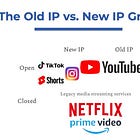Why "The Most Technologically Capable Media Company" Is Thinking About Technology Incorrectly
CEO David Ellison's vision for Paramount Skydance ignores the emerging "Red Pill" reality where AI turns consumers into creators competing with legacy media
[Author’s Note: I will be testing different copy for the About section and the tagline over the next few months. This is because I’m refining The Medium's positioning to focus on how AI is changing the fundamental economics of audience engagement for both platforms and IP holders.
I’d welcome your thoughts on how this aligns with the strategic challenges you're seeing.]
With the Paramount Skydance merger now final, new CEO David Ellison has been on a media tour touting the corporate objective of becoming “the most technologically capable media company”.
What does that mean?
Ellison wrote to shareholders that new management aims to “transform Paramount into a tech-forward company that blends the creative heart of Hollywood with the innovative spirit of Silicon Valley”. He offered one example to CNBC’s David Faber: Unifying the tech stack for Paramount Skydance’s three streaming services, which are currently “on three separate tech stacks on multiple clouds”.
Faber also pushed Ellison on the disruptive potential of AI. Ellison predicted that AI models “will eventually get to a place” where filmmakers will have “the same level of control” that they have on set with a camera and be able to “tell better stories” because they will “be able to iterate faster.”
If we reframe Ellison’s answer in terms of the “Red Pill” and “Blue Pill” marketplaces from recent essays, Ellison seems to believe in a “Blue Pill” marketplace. Meaning, he foresees the smart TV as the entertainment hub of the household and offers a mix of passive (streaming, broadcast and cable TV) and interactive (streaming, gaming) content consumption. Today’s announcement of a $7.7 billion deal for Paramount+ and CBS to become the exclusive home of UFC is proof of the pudding of his belief in that vision.
His answers reflect only “Blue Pill” thinking, ignoring the “Red Pill” marketplace where consumers become creators competing with legacy media companies.
Given AI's rapid evolution—ChatGPT-5 arrived just three months after GPT-4.1—the question is whether Ellison has his priorities right. Because, as I concluded last week, legacy media businesses like Paramount Skydance must now build portfolios across the “Blue Pill” and the “Red Pill” marketplaces. But Ellison prefers to sell a “Blue Pill” version of the future.
The “Red Pill” Marketplace
What Ellison did not say is that the “Red Pill” technologies for filmmakers to move faster and tell “better stories” are already here.








